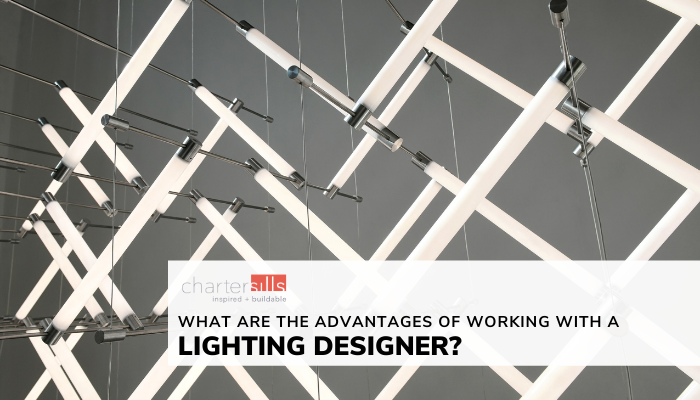"Light is the first element of design; Without it there is no color, form, or texture" – THOMAS FARIN
To the average person, lighting might sound like a consideration that comes fairly late in the architectural design process. It might feel like the bulk of the lighting design is more a question of interior design, on a par with choosing furniture or décor. Illumination plays a much larger role in architecture than most realize, however—most likely because when lighting is done well, we don’t necessarily notice it (well, at least until it gets dark outside). In this month’s blog, we look at the advantages of working with an architectural lighting designer in order to fully realize an architect’s vision.
A lighting designer brings technical and artistic prowess to the table
Lighting design can be viewed as a creative and functional extension of architectural design, which is why lighting designers work so closely with architects, from a project’s inception through construction. A good lighting design can make or break a building. Lighting can help create ambiance, lead patrons through a space, add height or depth to a structure, and improve functionality. To help a building’s illumination to work in harmony with the architectural design, an experienced lighting designer incorporates their knowledge not just of lighting, but also of architectural principles and practice. It is critical for a lighting scheme to work seamlessly with the overall design in order to fully realize the architect’s overall vision.
Technology evolves rapidly
New lighting equipment and control technologies are continually introduced to the marketplace. A lighting designer stays on top of new developments, understands which technologies will achieve the best results for the client’s goal and budget, and can provide impartial feedback to clients, so that major decisions are not based on sales pressure.
Architecture does not always involve new construction, however, and lighting design is also critical when it comes to renovations of existing spaces. Understanding the innovations in lighting fixtures, controls, and other technologies is important, but on many projects, a strong historical knowledge is also an important asset. A lighting designer can advise on what aspects of the existing need to be redone or how to capture the aesthetics and feel of a bygone era while incorporating modern technology.
One example of this is the work that our firm completed at Chicago Union Station’s Great Hall. The iconic Great Hall inside Chicago’s Union Station was designed in 1925 by renowned architecture firm Graham, Anderson, Probst, & White. To correct flaws in the original design that had contributed to water leakage and deterioration over time, a 42 month project was undertaken to provide substantial repairs and improvements to the space. With advancements in LED technology, the team was able to work with new lower profile fixtures. High performance, asymmetric LED cove lights were installed on the existing second-floor ledge that wraps around the Great Hall to provide the general lighting. Mockups were critical to make sure the fixtures were concealed almost entirely from the visitors view while still providing the distribution required. The results call attention to the volume of the space and intricate plaster detailing, not the fixtures.
Cost control through the construction process and beyond
A lighting designer can help create a lighting scheme that is cost effective during construction, but that will also keep costs down in the long run through energy efficiency and a number of other factors. First of all, an experienced lighting designer can help devise a budget tailored to the client’s financial, aesthetic, ergonomic, and environmental needs. Their experience can also help negotiate competitive pricing from manufacturers and electricians and spot anomalies in pricing to ensure that the client is getting a fair deal.
The experience a lighting designer brings to the project can also save the client money in the long term by implementing a cost-effective illumination scheme that will save on energy consumption. Saving money on energy costs can be accomplished through a variety of techniques. First and foremost, that means simply not over-illuminating a space. A lighting designer will be able to balance the availability of any natural light with the client’s needs to ensure they are not consuming more than needed. This requires an understanding of what kinds of activities will take place, and what degree of illumination they require. We explored some of the primary considerations when it comes to indoor over illumination in our last blog.
In addition, a lighting designer can incorporate smart controls, energy-efficient materials, and even décor recommendations that harness the reflectance of surfaces to boost illumination in the space. A lighting designer will also have a solid understanding of what kind of lighting is needed in order to support the space’s intended function, keeping abreast of research on how lighting impacts health, safety, and productivity. Building use is also not static; it often changes several times throughout the day and night. Maintenance needs for a building may evolve over time and across the seasons. An effective lighting designer needs a firm grasp of all these environmental factors in order to understand and predict needs the client may not even be aware of. This knowledge can help indirect, long-term costs effectiveness for clients down the line. By designing lighting that positively impacts retail sales, creates a more comfortable office environment, or improves security at a residence, the client will benefit through retention of employees or occupants.
Effective lighting design requires a jack of all trades
In a nutshell, effective lighting design requires a depth of knowledge across a variety of disciplines. A lighting design firm provides recommendations rooted in more than just wiring, bulbs, and controls. An effective illumination design is grounded in art, technology, and business. An effective lighting scheme fosters a mood, helps draw our attention through the space, and enhances the ergonomics of a building. By working with an architectural lighting designer, you will arrive at a plan created by experts with a firm grasp of architectural principles, technology, people, regulations, aesthetics, and the physics of light. Architecture is not just the creation of walls and a roof, it is an experience, and the work of a lighting designer brings that experience to life.


